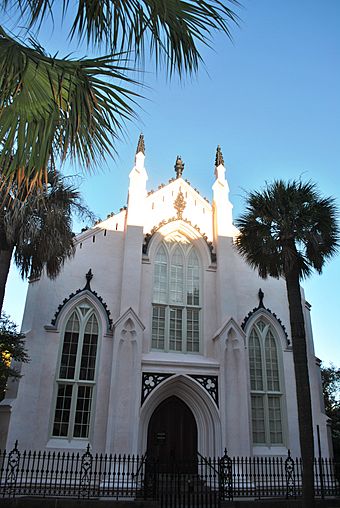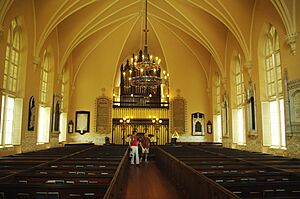Huguenot Church facts for kids
|
Huguenot Church
|
|

Huguenot Church
|
|
| Location | 136 Church St., Charleston, South Carolina |
|---|---|
| Built | 1844, consecrated 1845 |
| Architect | E. B. White (architect) |
| Architectural style | Gothic Revival church |
| NRHP reference No. | 73001687 |
Quick facts for kids Significant dates |
|
| Added to NRHP | November 7, 1973 |
| Designated NHL | November 7, 1973 |
The Huguenot Church, also known as the French Huguenot Church, is a beautiful church in Charleston, South Carolina. It's located at 136 Church Street. This church was built in 1844 and finished in 1845. It was designed by an architect named Edward Brickell White.
This church is special because it's the oldest Gothic Revival style church in South Carolina. It's so important that it's been named a National Historic Landmark. The group of people who attend this church started meeting way back in the 1680s. It is the only independent Huguenot church left in the United States.
Huguenots were Protestant Christians living in France. Back then, most people in France were Catholic. Huguenots often faced unfair treatment and were even persecuted. After a law called the Revocation of the Edict of Nantes was canceled in 1685, many Huguenots had to leave France. They went to many places around the world, including Charleston.
The first members of Charleston's Huguenot Church were many of these refugees. Their families continued to be involved with the church for a long time. The church was originally connected to the Reformed Church of France, which follows Calvinism. Even today, the church's beliefs still include parts of Calvinist ideas. The church services still use old French prayers and traditions from the 1700s, but they are now spoken in English.
The church is in an area of Charleston called the French Quarter. This name was given in 1973 to help protect the historic area. It was named this because many French business people used to live there. A very rich man from the past, Peter Manigault, is buried in the church's cemetery.
Contents
The Story of the Huguenots
Huguenots were French Calvinists who faced many challenges in France. Starting in the 1500s, they began to settle in other places. They tried to start colonies in Florida and South Carolina, but these didn't last. They also moved to places like South Africa, Britain, and existing colonies such as New Netherlands and Virginia.
In 1598, King Henry IV of France made a law called the Edict of Nantes. This law gave Huguenots certain rights and protections. But in 1685, King Louis XIV took away this law. This caused many Huguenots to leave France.
Building the Church
A group of 45 Huguenots arrived in Charleston in April 1680. The English King Charles II had sent them to work as skilled craftspeople. They started holding church services the next year. Reverend Phillip Trouillard is thought to have led the first service.
In 1687, Elias Prioleau became the church's first regular pastor. He had been a pastor in France before his church was destroyed in 1685. Prioleau stayed as pastor of the Charleston Huguenot Church until he passed away in 1699.
Many families were part of the church in its early years. These included the Gourdin, Ravenel, Porcher, and Huger families. It's hard to know everything about the church's very early days. Many of its old records were lost in a fire in 1740. Later, other families like the Bacot, Marion, and Laurens families also became involved. Huguenots kept moving to Carolina through the early 1700s. However, most of their churches eventually joined the Episcopal Church.
The first Huguenot Church building was on the same spot as the current one. City officials had to blow it up to stop a big fire from spreading. A simple brick church was built in its place in 1800. This second building was taken down in 1844 to make way for the church we see today. The current church was finished the next year.
This third church was damaged during the Civil War. It was also hurt by the Charleston Earthquake of 1886. A descendant of Huguenots, Charles Lanier from New York, helped pay to fix it. The church is surrounded by a graveyard where many Huguenots are buried.
In the early 1800s, fewer people were members of the church. So, in 1828, the church started changing its French services into English. With the new English services, a grand new building, and inspiring pastors, more people joined the church.
By 1912, membership had dropped again. For most of the 1900s, the church wasn't used for regular services. The local Huguenot families would sometimes open it for weddings or organ concerts. The Huguenot Society of South Carolina also held occasional services there. The church's current regular congregation started in 1983.
Church Design and Features
The church you see today was designed by Edward Brickell White. He was a local architect who designed many buildings in the area. The church was built by Ephraim Curtis, a local builder.
The church is made of brick covered in stucco. It has three wide sections and six long sections. Each section is separated by narrow buttresses, which are supports that stick out from the wall. These supports have fancy decorations on top. The three front windows have decorative metalwork called crockets. A decorative wall, like a castle wall, goes around the top of the church.
Inside, the walls have plaster ceilings with ribbed designs. There are also marble tablets with the names of Huguenot families carved into them.
The church's organ was bought in 1845. It's a special type of organ called a tracker organ. It was made by Henry Erben from New York. A "tracker" system connects the keys directly to the pipes. This makes the organ respond very quickly when the organist plays. The sound of this organ is similar to organs used a long time ago, during the Baroque period.
Current Church Activities
The Huguenot Church now holds regular services. These services are in English. However, since 1950, there's been a special service every April. This service includes French readings to remember the Edict of Nantes, which was adopted in April 1598.
The church still teaches Calvinist beliefs. Its services follow traditions developed in places like Neufchâtel and Vallangin in the 1700s. A group of directors and elders helps to run the church.
See also
- Reformed Church of France
- French Confession of Faith
- List of Huguenots
- Bible translations into French
- List of National Historic Landmarks in South Carolina
- National Register of Historic Places listings in Charleston, South Carolina





